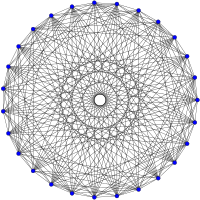Schläfli graph
| Schläfli graph | |
|---|---|
 |
|
| Vertices | 27 |
| Edges | 216 |
| Radius | 2 |
| Diameter | 2 |
| Girth | 3 |
| Automorphisms | 51840 |
| Chromatic number | 9 |
| Properties |
Strongly regular Claw-free Hamiltonian |
In the mathematical field of graph theory, the Schläfli graph, named after Ludwig Schläfli, is a 16-regular undirected graph with 27 vertices and 216 edges. It is a strongly regular graph with parameters srg(27, 16, 10, 8).
The intersection graph of the 27 lines on a cubic surface is the complement of the Schläfli graph. That is, two vertices are adjacent in the Schläfli graph if and only if the corresponding pair of lines are skew.
The Schläfli graph may also be constructed from the system of eight-dimensional vectors
and the 24 other vectors obtained by permuting the first six coordinates of these three vectors. These 27 vectors correspond to the vertices of the Schläfli graph; two vertices are adjacent if and only if the corresponding two vectors have 1 as their inner product.
Alternately, this graph can be seen as the complement of the collinearity graph of the generalized quadrangle GQ(2,4).
The neighborhood of any vertex in the Schläfli graph forms a 16-vertex subgraph in which each vertex has 10 neighbors (the numbers 16 and 10 coming from the parameters of the Schläfli graph as a strongly regular graph). These subgraphs are all isomorphic to the complement graph of the Clebsch graph. Since the Clebsch graph is triangle-free, the Schläfli graph is claw-free. It plays an important role in the structure theory for claw-free graphs by Chudnovsky & Seymour (2005).
...
Wikipedia
